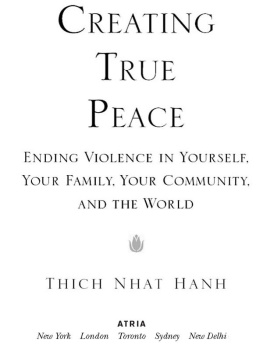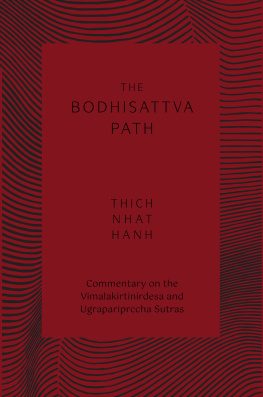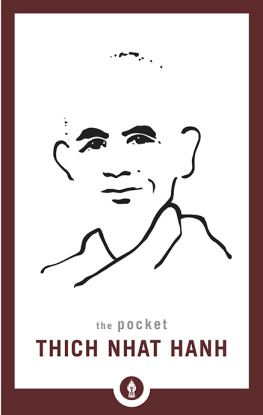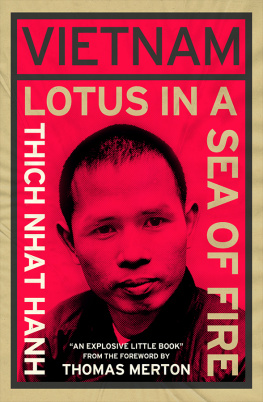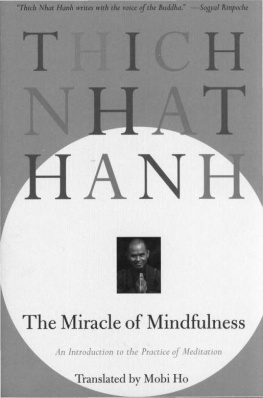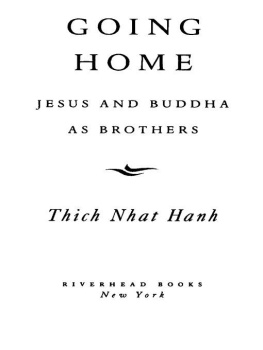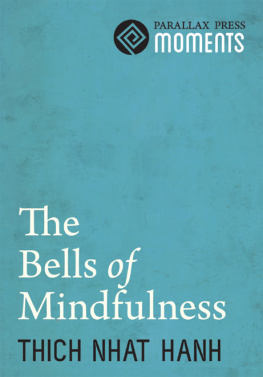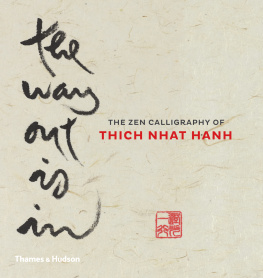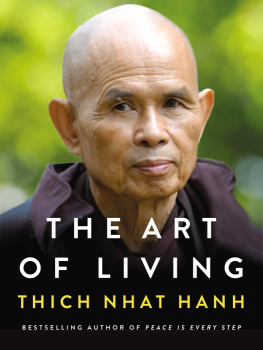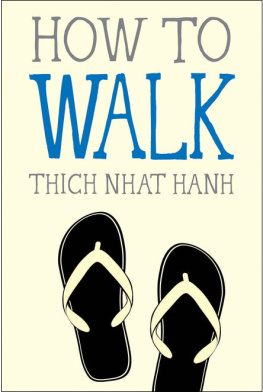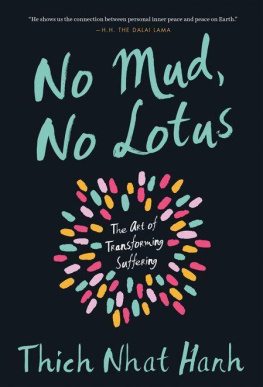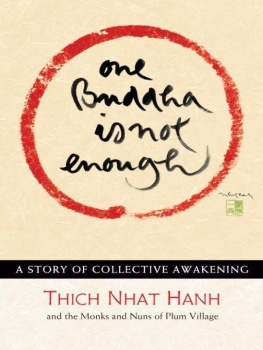Table of Contents
WELCOME
WELCOME
BROTHERS AND SISTERS, please read The Diamond That Cuts through Illusion with a serene mind, a mind free from views. Its the basic sutra for the practice of meditation. Late at night, its a pleasure to recite the Diamond Sutra alone, in complete silence. The sutra is so deep and wonderful. It has its own language. The first Western scholars who obtained the text thought it was talking nonsense. Its language seems mysterious, but when you look deeply, you can understand.
Dont rush into the commentaries or you may be unduly influenced by them. Please read the sutra first. You may see things that no commentator has seen. You can read as if you were chanting, using your clear body and mind to be in touch with the words. Try to understand the sutra from your own experiences and your own suffering. It is helpful to ask, Do these teachings of the Buddha have anything to do with my daily life? Abstract ideas can be beautiful, but if they have nothing to do with our life, of what use are they? So please ask, Do the words have anything to do with eating a meal, drinking tea, cutting wood, or carrying water?
The sutras full name is The Diamond That Cuts through Illusion , Vajracchedika Prajaparamita in Sanskrit. Vajracchedika means the diamond that cuts through afflictions, ignorance, delusion, or illusion. In China and Vietnam, people generally call it the Diamond Sutra, emphasizing the word diamond, but, in fact, the phrase cutting through is the most important. Prajaparamita means perfection of wisdom, transcendent understanding, or the understanding that brings us across the ocean of suffering to the other shore. Studying and practicing this sutra can help us cut through ignorance and wrong views and transcend them, transporting ourselves to the shore of liberation.
THE VAJRACCHEDIKA PRAJAPARAMITA SUTRA
THE VAJRACCHEDIKA PRAJAPARAMITA SUTRA
This is what I heard one time when the Buddha was staying in the monastery in Anathapindikas park in the Jeta Grove near Shravasti with a community of 1,250 bhikshus, fully ordained monks.
That day, when it was time to make the round for alms, the Buddha put on his sanghati robe and, holding his bowl, went into the city of Shravasti to seek alms food, going from house to house. When the almsround was completed, he returned to the monastery to eat the midday meal. Then he put away his sanghati robe and his bowl, washed his feet, arranged his cushion, and sat down.
At that time, the Venerable Subhuti stood up, bared his right shoulder, put his knee on the ground, and, folding his palms respectfully, said to the Buddha, World-Honored One, it is rare to find someone like you. You always support and show special confidence in the bodhisattvas.
World-Honored One, if sons and daughters of good families want to give rise to the highest, most fulfilled, awakened mind, what should they rely on and what should they do to master their thinking?
The Buddha replied, Well said, Subhuti! What you have said is absolutely correct. The Tathagata always supports and shows special confidence in the bodhisattvas. Please listen with all of your attention and the Tathagata will respond to your question. If daughters and sons of good families want to give rise to the highest, most fulfilled, awakened mind, they should rely on the following and master their thinking in the following way.
The Venerable Subhuti said, Lord, we are so happy to hear your teachings.
The Buddha said to Subhuti, This is how the bodhisattva mahasattvas master their thinking. However many species of living beings there arewhether born from eggs, from the womb, from moisture, or spontaneously; whether they have form or do not have form; whether they have perceptions or do not have perceptions; or whether it cannot be said of them that they have perceptions or that they do not have perceptions, we must lead all these beings to the ultimate nirvana so that they can be liberated. And when this innumerable, immeasurable, infinite number of beings has become liberated, we do not, in truth, think that a single being has been liberated.
Why is this so? If, Subhuti, a bodhisattva holds on to the idea that a self, a person, a living being, or a life span exists, that person is not an authentic bodhisattva.
Moreover, Subhuti, when a bodhisattva practices generosity, he does not rely on any objectthat is to say he does not rely on any form, sound, smell, taste, tactile object, or dharmato practice generosity. That, Subhuti, is the spirit in which a bodhisattva should practice generosity, not relying on signs. Why? If a bodhisattva practices generosity without relying on signs, the happiness that results cannot be conceived of or measured. Subhuti, do you think that the space in the Eastern Quarter can be measured?
No, World-Honored One.
Subhuti, can space in the Western, Southern, and Northern Quarters, above and below be measured?
No, World-Honored One.
Subhuti, if a bodhisattva does not rely on any concept when practicing generosity, then the happiness that results from that virtuous act is as great as space. It cannot be measured. Subhuti, the bodhisattvas should let their minds dwell in the teachings I have just given.
What do you think, Subhuti? Is it possible to grasp the Tathagata by means of bodily signs?
No, World-Honored One. When the Tathagata speaks of bodily signs, there are no signs being talked about.
The Buddha said to Subhuti, In a place where there is something that can be distinguished by signs, in that place there is deception. If you can see the signless nature of signs, then you can see the Tathagata.
The Venerable Subhuti said to the Buddha, In times to come, will there be people who, when they hear these teachings, have real faith and confidence in them?
The Buddha replied, Do not speak that way, Subhuti. Five hundred years after the Tathagata has passed away, there will still be people who enjoy the happiness that comes from observing the precepts. When such people hear these words, they will have faith and confidence that here is the truth. We should know that such people have sown seeds not only during the lifetime of one Buddha, or even two, three, four, or five Buddhas, but have, in truth, planted wholesome seeds during the lifetimes of tens of thousands of Buddhas. Anyone who, for only a second, gives rise to a pure and clear confidence upon hearing these words of the Tathagata, the Tathagata sees and knows that person, and he or she will attain immeasurable happiness because of this understanding. Why?
Because that kind of person is not caught up in the idea of a self, a person, a living being, or a life span. They are not caught up in the idea of a dharma or the idea of a non-dharma. They are not caught up in the notion that this is a sign and that is not a sign. Why? If you are caught up in the idea of a dharma, you are also caught up in the ideas of a self, a person, a living being, and a life span. If you are caught up in the idea that there is no dharma, you are still caught up in the ideas of a self, a person, a living being, and a life span. That is why we should not get caught up in dharmas or in the idea that dharmas do not exist. This is the hidden meaning when the Tathagata says, Bhikshus, you should know that all of the teachings I give to you are a raft. All teachings must be abandoned, not to mention non-teachings.


